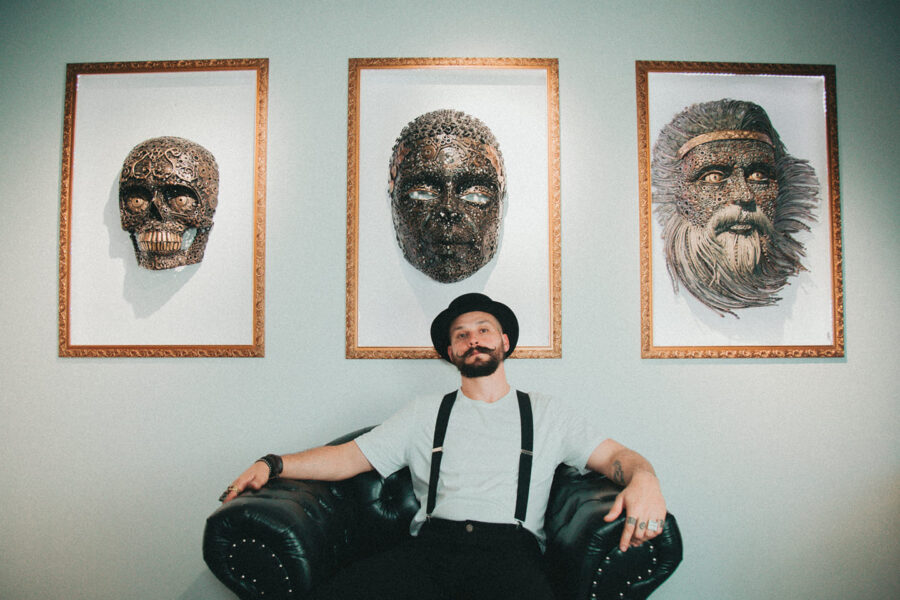The primal allure of metal, forged and manipulated by human hands, resonates deeply within our collective consciousness. From ancient tools and weaponry to towering architectural feats, its strength and malleability have long captivated artists seeking to give tangible form to their inner visions. Within this enduring tradition, the work of Michel Torres Costa emerges as a compelling exploration of the liminal space between industrial rigor and organic fluidity. Costa’s sculptures, born from the intense heat of the forge, transcend the inherent rigidity of their medium, evolving into intricate, seemingly living forms that invite contemplation on the dynamic interplay between nature and artifice. His practice underscores a vital contemporary dialogue: how can time-honored techniques be reimagined to articulate the complexities of our rapidly changing world, and how can the inherent weight and permanence of metal speak to the delicate and ephemeral qualities of the natural realm?
The Forging of a Vision: Historical and Conceptual Roots
The art of metal sculpture boasts a rich and varied history, stretching back millennia. Early examples, often imbued with ritualistic or utilitarian purpose, gradually evolved into expressions of aesthetic and symbolic intent. From the lost-wax casting techniques of ancient civilizations to the monumental bronze figures of the Renaissance, artists have continually pushed the boundaries of what metal can become. The 20th century witnessed a radical transformation in sculptural practice, with artists like Julio González and David Smith pioneering the direct manipulation of welded steel, embracing the industrial aesthetic and opening up new possibilities for abstract and spatial exploration. Costa’s work, while deeply informed by this lineage of metalworking, particularly resonates with a more recent trend that seeks to bridge the gap between the manufactured and the natural. Artists exploring biomorphic forms and organic structures within industrial materials have created a fertile ground for Costa’s unique vocabulary to flourish. His dedication to the visceral process of forging, a technique with roots in ancient craft, connects him to a lineage of makers who understood the intimate relationship between the artist, the material, and the transformative power of heat and force.
The Contemporary Landscape: Organic Forms in Metal
Michel Torres Costa’s current body of work stands as a testament to the enduring power of skilled craftsmanship in a technologically saturated age. His sculptures, primarily crafted from steel and bronze, are characterized by their intricate networks of interconnected elements. These forms often evoke botanical structures, marine life, or the delicate tracery of veins and capillaries. Yet, they remain resolutely metallic, the weight and texture of the material providing a grounding counterpoint to their seemingly organic growth. Recent exhibitions have highlighted Costa’s mastery of techniques such as hammer forging, welding, and patination, allowing him to achieve a remarkable level of detail and nuanced surface finishes. His pieces are not mere representations of nature; rather, they embody a process of material transformation that mirrors the growth and decay inherent in the natural world. This approach resonates with contemporary dialogues surrounding sustainability and our relationship with the environment, prompting viewers to consider the inherent beauty and potential for transformation within seemingly rigid materials. Costa’s work has garnered increasing attention within the art world, finding its place in both private collections and public installations, a testament to its compelling visual language and intellectual depth.
Critical Perspectives: Between Artifice and Authenticity
While Costa’s evocative forms and technical virtuosity have been widely praised, critical discourse surrounding his work also touches upon broader questions within contemporary sculpture. One area of discussion revolves around the perceived tension between the industrial nature of his materials and the organic forms he creates. Some critics might argue that the overt representation of natural forms in metal can feel somewhat paradoxical, potentially undermining the inherent qualities of the medium. Others, however, see this juxtaposition as a strength, a deliberate exploration of the interplay between the manufactured and the natural, reflecting our increasingly complex relationship with the environment and technology. Furthermore, the intensive labor involved in traditional metalworking raises questions about the role of craft in an art world often dominated by conceptual and digital practices. Is Costa’s dedication to the forge a nostalgic embrace of traditional methods, or a vital assertion of the enduring value of skilled handwork in an age of mass production? These critical perspectives serve to enrich our understanding of Costa’s oeuvre, positioning it within a broader conversation about materiality, representation, and the evolving definition of contemporary sculpture.
Forging the Future: Emerging Trends and Evolving Forms
Looking ahead, several trends suggest the continued relevance and evolution of Costa’s sculptural practice. The increasing interest in sustainable art practices and the exploration of recycled and repurposed materials could further inform his creative process. His existing engagement with natural forms might also lead to collaborations with scientists or environmental organizations, exploring the intersection of art and ecological awareness. Furthermore, advancements in digital fabrication and material science could offer new avenues for experimentation, perhaps allowing for the integration of digitally designed elements with his hand-forged techniques. The art market’s growing appreciation for technically skilled and conceptually engaging sculptural work suggests a continued demand for Costa’s unique vision. As societal concerns around environmental degradation and the impact of technology on the natural world intensify, artists like Michel Torres Costa, who bridge the divide between the industrial and the organic, are likely to play an increasingly important role in shaping our visual and intellectual landscape. His continued exploration of metal as a medium for expressing the delicate beauty and inherent power of the natural world promises a compelling trajectory for his artistic practice.
Michel Torres Costa’s sculptures offer a potent reminder of the enduring capacity of art to transform and transcend its material origins. Through the alchemical process of forging metal into seemingly organic forms, he invites us to reconsider our relationship with both the industrial and the natural. His work is not simply about representation; it is about the inherent dynamism of creation and the potential for unexpected beauty to emerge from the most rigid of substances. As we navigate an increasingly complex world, Costa’s sculptures serve as a compelling testament to the power of artistic vision to forge new connections and inspire ongoing dialogue about the world around us.









